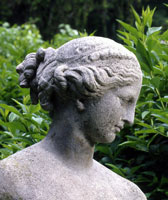
Classical Inspiration in the Garden
By Barbara Israel
The influence of classical forms on garden ornament cannot be overstated. They are a constant in our field and we spend considerable time analyzing symbols and attributes and generally admiring their sublime renderings in stone, bronze, terra cotta and cast iron. Since the early 18th century, prominent Americans have paid homage to classical gardens by selecting statuary with mythological themes. The multitude of subjects included in the Greek and Roman pantheon is vast but, suffice it to say, that figures of the gods and goddesses of the sun, the earth, the woodland, love, poetry and the arts have a long history in the gardens of Europe and America. (PHOTO: DETAIL OF A CIRCA 1860 FIGURE OF VENUS)
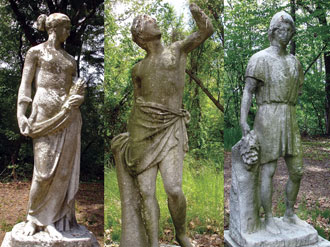 For the Virginian William Byrd II (1674-1744), who often rose before dawn to read Thucydides and Homer, the presence of mythological statues in the garden of his home, Westover, reflected his knowledge of Greek history and epic poetry. Moreover, while the inclusion of allegorical sculpture in the garden confirmed the owner’s refined taste, apt placement, such as situating satyrs in a woodland setting, indicated the breadth of his knowledge. In about 1740, John Custis (1678-1749), the first father-in-law of Martha Washington, set up lead statues referencing Roman mythology in his four-acre garden in Williamsburg, VA. And a mention of allegorical statues was made in the 1762 diary of a female visitor to Belmont, the 1745 home of William Peters (1702-1786) in the Fairmount Park section of Philadelphia: “In the middle stands a statue of Apollo. In the garden are statues of Diana, Fame and Mercury…” (PHOTO: BELMONT FIGURES)
For the Virginian William Byrd II (1674-1744), who often rose before dawn to read Thucydides and Homer, the presence of mythological statues in the garden of his home, Westover, reflected his knowledge of Greek history and epic poetry. Moreover, while the inclusion of allegorical sculpture in the garden confirmed the owner’s refined taste, apt placement, such as situating satyrs in a woodland setting, indicated the breadth of his knowledge. In about 1740, John Custis (1678-1749), the first father-in-law of Martha Washington, set up lead statues referencing Roman mythology in his four-acre garden in Williamsburg, VA. And a mention of allegorical statues was made in the 1762 diary of a female visitor to Belmont, the 1745 home of William Peters (1702-1786) in the Fairmount Park section of Philadelphia: “In the middle stands a statue of Apollo. In the garden are statues of Diana, Fame and Mercury…” (PHOTO: BELMONT FIGURES)
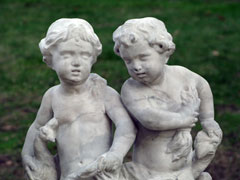 Today, classical ornaments remain enormously popular. Currently we have in stock a pair of statues that depict Hera, Zeus, Ariadne and Bacchus as children. How did we recognize them? Why, the peacock standing next to Hera is her symbol, the eagle distinguishes Zeus, the grapes identify Bacchus and Ariadne is shown with a white goose, an allusion to her association with Aphrodite. For me, being informed about mythological subject matter is essential. Our clients enjoy knowing the fables attached to the statues and the explanations add greatly to their appeal. One of our clients bought a magnificent bronze plaque of Orpheus from us precisely because of his passion for that particular myth. (PHOTO: DETAIL OF HERA AND ZEUS)
Today, classical ornaments remain enormously popular. Currently we have in stock a pair of statues that depict Hera, Zeus, Ariadne and Bacchus as children. How did we recognize them? Why, the peacock standing next to Hera is her symbol, the eagle distinguishes Zeus, the grapes identify Bacchus and Ariadne is shown with a white goose, an allusion to her association with Aphrodite. For me, being informed about mythological subject matter is essential. Our clients enjoy knowing the fables attached to the statues and the explanations add greatly to their appeal. One of our clients bought a magnificent bronze plaque of Orpheus from us precisely because of his passion for that particular myth. (PHOTO: DETAIL OF HERA AND ZEUS)
While the taste for classical ornament is certainly an important theme in my book, Antique Garden Ornament: Two Centuries of American Taste, it is the main focus of Francis Haskell and Nicholas Penny’s Taste and the Antique, one of my favorite source books on this subject. While I knew that Roman and Greek mythological statues had been used in estate gardens since the early 1700s, the more striking thing that I found in Taste and the Antique was the popularization of classical forms through public exhibitions. One amusing example recounts that in 1803, the newly formed Society of Fine Arts in New York purchased and exhibited 16 plaster casts of antique statues from the Louvre for artists to study and emulate. On a designated day the show was announced as being open to female viewers, but only after fig leaves had been attached to the statues so as not to offend the ladies’ sensibilities! Happily in the 21st century we are way beyond such excessive modesty and can all appreciate classical statues for their impeccable standards of beauty.
Favorite Classical Models
By Eva Schwartz and Katy Keiffer
As Barbara mentions in her introduction, when she was writing her book years ago one of her favorite sources and inspirations was the incomparable Taste and the Antique (1981) by Francis Haskell and Nicholas Penny. This essential book is a catalogue of the most celebrated classical sculptures, providing photographs and historical details of 95 great works. Apart from being incredibly useful, the book provides a fascinating and entertaining analysis of the nearly universal reverence for these sculptures beginning in the early 16th century.
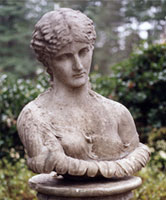 On a practical level, Taste and the Antique is our go-to source whenever a classical figure comes our way–whether we’re dealing with an unmistakably famous statue like the Venus de Medici or a less-known model that begs identification. But more profoundly, the book is a jumping-off point whenever we consider the pervasive and often capricious idea of Taste. From the 16th through 19th centuries, the classical sculptures detailed in Haskell & Penny’s book provided a marker for Absolute Beauty and mastery of the classical style was required of all serious artists. Even now, when art appreciation has become so diversified and classical sculpture is no longer viewed as the unequivocal measure of artistic value, time-tested classical models continue to resonate strongly with collectors. Whether for a stately Italianate garden or an austere modern landscape, the right classical figure seems to impart just the right note of seriousness and refinement. And from a market standpoint, a serene and beautiful classical statue, particularly female, is infinitely saleable. (PHOTO: CIRCA 1850 BUST OF CLYTIE, AFTER THE AD 40-50 ROMAN ORIGINAL)
On a practical level, Taste and the Antique is our go-to source whenever a classical figure comes our way–whether we’re dealing with an unmistakably famous statue like the Venus de Medici or a less-known model that begs identification. But more profoundly, the book is a jumping-off point whenever we consider the pervasive and often capricious idea of Taste. From the 16th through 19th centuries, the classical sculptures detailed in Haskell & Penny’s book provided a marker for Absolute Beauty and mastery of the classical style was required of all serious artists. Even now, when art appreciation has become so diversified and classical sculpture is no longer viewed as the unequivocal measure of artistic value, time-tested classical models continue to resonate strongly with collectors. Whether for a stately Italianate garden or an austere modern landscape, the right classical figure seems to impart just the right note of seriousness and refinement. And from a market standpoint, a serene and beautiful classical statue, particularly female, is infinitely saleable. (PHOTO: CIRCA 1850 BUST OF CLYTIE, AFTER THE AD 40-50 ROMAN ORIGINAL)
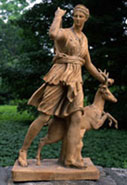 As dealers we love telling the stories of objects–and Antique models provide some of the best. Four of our favorites, Diane Chasseresse, Diana de Gabii, the Warwick Urn and the Piping Faun, all highlighted in Taste and the Antique,have been reproduced for centuries. The first of these is Diane Chasseresse, also known as Diane a la Biche or Diane de Versailles. Now in the Louvre, the Diane Chasseresse was coveted by Henri II (1519-1559) who saw it first in Rome, in the collection of Pope Paul IV. The Pope offered it to him as a gift in 1556, a knowing allusion to Henri’s famous mistress, Diane de Poitiers. The piece was on view at the Palace of Fontainebleau until it was transferred to the Louvre in 1602. During the reign of Louis XIV, it was sent to Versailles, but a 1792 decree ordered it back to Paris, where it has been ever since. The marble in the Louvre is a Roman copy of a now lost Greek bronze thought to have been executed around 325 BC by Leochares–the sculptor to which the Apollo Belvedere is often attributed. (PHOTO: CIRCA 1880 FRENCH TERRA-COTTA EXAMPLE OF DIANE CHASSERESSE)
As dealers we love telling the stories of objects–and Antique models provide some of the best. Four of our favorites, Diane Chasseresse, Diana de Gabii, the Warwick Urn and the Piping Faun, all highlighted in Taste and the Antique,have been reproduced for centuries. The first of these is Diane Chasseresse, also known as Diane a la Biche or Diane de Versailles. Now in the Louvre, the Diane Chasseresse was coveted by Henri II (1519-1559) who saw it first in Rome, in the collection of Pope Paul IV. The Pope offered it to him as a gift in 1556, a knowing allusion to Henri’s famous mistress, Diane de Poitiers. The piece was on view at the Palace of Fontainebleau until it was transferred to the Louvre in 1602. During the reign of Louis XIV, it was sent to Versailles, but a 1792 decree ordered it back to Paris, where it has been ever since. The marble in the Louvre is a Roman copy of a now lost Greek bronze thought to have been executed around 325 BC by Leochares–the sculptor to which the Apollo Belvedere is often attributed. (PHOTO: CIRCA 1880 FRENCH TERRA-COTTA EXAMPLE OF DIANE CHASSERESSE)
 The first known reproduction of Diane Chasseresse was cast in bronze in 1605 to be displayed at Fontainebleau after the marble figure was sent to the Louvre. Since then, of course, the model has been copied innumerable times, but has managed to avoid any connotations of cliché that has plagued other famous statues like the Venus de Milo. We have owned and/or seen 19th-century examples of this figure in cast iron, composition stone, terra cotta (above), limestone (right), and marble. It appears in trade catalogues of the most influential garden ornament makers of the 19th century–English terra-cotta maker John Marriott Blashfield offered it from the 1850s onward; Austin & Seeley, the renowned British composition stone manufacturer, produced a version during the third quarter of the 19th century; J. W. Fiske Iron Works of New York sold a zinc example, termed “Diana with Stag”, in their 1874 catalogue; and, toward the end of the 19th century, the famed Parisian bronze foundry, Barbedienne, cast the figure in six sizes. The most memorable Diane Chasseresse we ever owned was of limestone and measured ten feet high on its pedestal. We heard from the seller that he had to remove it from an indoor pool court by lifting it by crane through a hole in the roof! (PHOTO: MONUMENTAL CIRCA 1900 FRENCH LIMESTONE DIANE CHASSERESSE)
The first known reproduction of Diane Chasseresse was cast in bronze in 1605 to be displayed at Fontainebleau after the marble figure was sent to the Louvre. Since then, of course, the model has been copied innumerable times, but has managed to avoid any connotations of cliché that has plagued other famous statues like the Venus de Milo. We have owned and/or seen 19th-century examples of this figure in cast iron, composition stone, terra cotta (above), limestone (right), and marble. It appears in trade catalogues of the most influential garden ornament makers of the 19th century–English terra-cotta maker John Marriott Blashfield offered it from the 1850s onward; Austin & Seeley, the renowned British composition stone manufacturer, produced a version during the third quarter of the 19th century; J. W. Fiske Iron Works of New York sold a zinc example, termed “Diana with Stag”, in their 1874 catalogue; and, toward the end of the 19th century, the famed Parisian bronze foundry, Barbedienne, cast the figure in six sizes. The most memorable Diane Chasseresse we ever owned was of limestone and measured ten feet high on its pedestal. We heard from the seller that he had to remove it from an indoor pool court by lifting it by crane through a hole in the roof! (PHOTO: MONUMENTAL CIRCA 1900 FRENCH LIMESTONE DIANE CHASSERESSE)
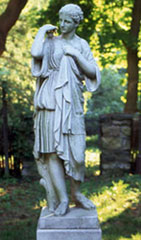 Diana de Gabii, a 1st century Roman statue apparently based on Greek sculptor Praxiteles’ 4th century BC work, was discovered in 1782 in Gabii, near Rome. Following initial ownership by the Borghese family, it was sold to Napoleon I in 1807 and was installed in the Louvre, where it remains. It received rapturous praise from 18th and 19th century writers, including Ennio Quirino Visconti (1751-1818), the curator of antiquities at the Louvre, citing the statue as an undisputed masterpiece. In the mid-to-late 19th century, the figure was produced abroad in an array of materials–in terra cotta by, among others, J. M. Blashfield, appearing in varying sizes in the firm’s 1850s/60s catalogs as “Diana Robing”; in cast iron by the Val d’Osne foundry of Paris and the Durenne foundry of Sommevoire, France; and in bronze by Barbedienne, offered in nine sizes in 1886. In the United States, in the early 20th century, terra-cotta versions were produced by Galloway Terra Cotta Company of Philadelphia and by J. Franklin Whitman Co., a lesser-known Philadelphia maker. Barbara once owned an especially fine example of this figure that had the most beautiful crackled surface; it was attributed to Blashfield and dated to the 1850s. (PHOTO: CIRCA 1850 ENGLISH MARBLE EXAMPLE OF DIANA DE GABII)
Diana de Gabii, a 1st century Roman statue apparently based on Greek sculptor Praxiteles’ 4th century BC work, was discovered in 1782 in Gabii, near Rome. Following initial ownership by the Borghese family, it was sold to Napoleon I in 1807 and was installed in the Louvre, where it remains. It received rapturous praise from 18th and 19th century writers, including Ennio Quirino Visconti (1751-1818), the curator of antiquities at the Louvre, citing the statue as an undisputed masterpiece. In the mid-to-late 19th century, the figure was produced abroad in an array of materials–in terra cotta by, among others, J. M. Blashfield, appearing in varying sizes in the firm’s 1850s/60s catalogs as “Diana Robing”; in cast iron by the Val d’Osne foundry of Paris and the Durenne foundry of Sommevoire, France; and in bronze by Barbedienne, offered in nine sizes in 1886. In the United States, in the early 20th century, terra-cotta versions were produced by Galloway Terra Cotta Company of Philadelphia and by J. Franklin Whitman Co., a lesser-known Philadelphia maker. Barbara once owned an especially fine example of this figure that had the most beautiful crackled surface; it was attributed to Blashfield and dated to the 1850s. (PHOTO: CIRCA 1850 ENGLISH MARBLE EXAMPLE OF DIANA DE GABII)
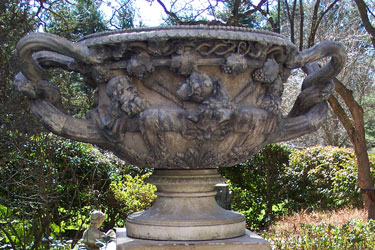 The robust, immense form (nearly 10 feet high and 9 feet wide) of the Warwick Urn, or Vase, has inspired praise since its discovery in 1770/71. The discovery is credited to Gavin Hamilton, a Scottish Neoclassical painter, antiquarian and art dealer, who spent most of his life in Rome. He reputedly spent years doing excavations around Hadrian’s Villa, finding the colossal urn at nearby Lake Tivoli. Recovered in multiple pieces, the urn was given to Hamilton’s cousin, Sir William Hamilton, the British ambassador to the court of Naples. On the advice of artist and historian Giovanni Battista Piranesi (1720-1778), Sir Hamilton had the dealer James Byres restore the enormous urn by setting the fragments into a new Carrara marble body. Due to missing pieces, the restoration required a good deal of invention, with Hamilton, Byres and Piranesi all weighing in on the final design. After the restoration was complete, Sir Hamilton supposedly aspired to sell the urn to the British Museum, but–owing to the new design elements–it did not live up to the Museum’s standards of archaeological accuracy.Eventually Sir Hamilton persuaded his nephew, George Greville, the 2nd Earl of Warwick, to place it on the grounds of Warwick Castle and the urn is now in the Burrell Collection in Glasgow, Scotland.(PHOTO: 20TH CENTURY 52-INCH-WIDE ENGLISH STONEWARE EXAMPLE OF THE “WARWICK URN)
The robust, immense form (nearly 10 feet high and 9 feet wide) of the Warwick Urn, or Vase, has inspired praise since its discovery in 1770/71. The discovery is credited to Gavin Hamilton, a Scottish Neoclassical painter, antiquarian and art dealer, who spent most of his life in Rome. He reputedly spent years doing excavations around Hadrian’s Villa, finding the colossal urn at nearby Lake Tivoli. Recovered in multiple pieces, the urn was given to Hamilton’s cousin, Sir William Hamilton, the British ambassador to the court of Naples. On the advice of artist and historian Giovanni Battista Piranesi (1720-1778), Sir Hamilton had the dealer James Byres restore the enormous urn by setting the fragments into a new Carrara marble body. Due to missing pieces, the restoration required a good deal of invention, with Hamilton, Byres and Piranesi all weighing in on the final design. After the restoration was complete, Sir Hamilton supposedly aspired to sell the urn to the British Museum, but–owing to the new design elements–it did not live up to the Museum’s standards of archaeological accuracy.Eventually Sir Hamilton persuaded his nephew, George Greville, the 2nd Earl of Warwick, to place it on the grounds of Warwick Castle and the urn is now in the Burrell Collection in Glasgow, Scotland.(PHOTO: 20TH CENTURY 52-INCH-WIDE ENGLISH STONEWARE EXAMPLE OF THE “WARWICK URN)
Despite the rejection by the British Museum, there is no denying the Warwick Urn’s historical and academic importance; its rebuilt and altered form is contemporary taste-making at its best. In fact, its reputation was so exalted that Napoleon I (reign 1804-1814) placed it first on his list of spoils should he ever succeed in conquering Great Britain.
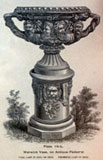 Only a handful of full-size copies of the Warwick Urn were ever made, but smaller-scale versions were produced in nearly every conventional material. In Great Britain, in the mid-to-late 19th century, J. M. Blashfield, Garnkirk, Doulton and M. H. Blanchard produced the Warwick model in terra cotta. In France, cast-iron manufacturers such as Val d’Osne offered it in the last quarter of the 19th century, along with bronze makers such as Barbedienne. In the United States, Galloway & Graff of Philadelphia produced a Warwick Urn in terra cotta exhibited at the 1876 Centennial exhibition that may have inspired J. L. Mott Iron Works (New York) to include the model in its later catalogues. The Warwick Urn remains, rivaled only by the Medici and Borghese vases, as the most familiar and copied vessel of the Classical oeuvre. (PHOTO: 1893 J. W. MOTT IRON WORKS CATALOGUE OFFERING OF THE “WARWICK VASE ON ANTIQUE PEDESTAL”)
Only a handful of full-size copies of the Warwick Urn were ever made, but smaller-scale versions were produced in nearly every conventional material. In Great Britain, in the mid-to-late 19th century, J. M. Blashfield, Garnkirk, Doulton and M. H. Blanchard produced the Warwick model in terra cotta. In France, cast-iron manufacturers such as Val d’Osne offered it in the last quarter of the 19th century, along with bronze makers such as Barbedienne. In the United States, Galloway & Graff of Philadelphia produced a Warwick Urn in terra cotta exhibited at the 1876 Centennial exhibition that may have inspired J. L. Mott Iron Works (New York) to include the model in its later catalogues. The Warwick Urn remains, rivaled only by the Medici and Borghese vases, as the most familiar and copied vessel of the Classical oeuvre. (PHOTO: 1893 J. W. MOTT IRON WORKS CATALOGUE OFFERING OF THE “WARWICK VASE ON ANTIQUE PEDESTAL”)
The Faun with Pipes, in the Louvre, is one of many Antique faun figures to achieve celebrity status in the years  following its discovery in the early 17th century. It is particularly similar to the Marble Faun in the collection of the Capitoline Museum in Rome, with each statue having been linked at various points to the Praxiteles’ now-lost 4th-century bronze (although the Faun with Pipes’ connection to the bronze has now been discredited). Taste and the Antique cites the Faun with Pipes as the most replicated–and least denigrated–statue of its type. The funny thing we discovered about the model was how distinctly the form was altered to keep step with standards of modesty in the late 19th century–cast-iron examples by Val d’Osne from their 1870 catalogue show the figure draped with a lion pelt; Barbedienne’s 1886 version was the closest to the original, with no draping; and in 1890, J. L. Mott’s cast-iron figure called “Faun Blowing Flute” is shown with a decorous fig leaf. Of the examples we have owned, our favorite is an 1860 French cast-iron one (at right) that is now happily situated at a historic southern plantation.
following its discovery in the early 17th century. It is particularly similar to the Marble Faun in the collection of the Capitoline Museum in Rome, with each statue having been linked at various points to the Praxiteles’ now-lost 4th-century bronze (although the Faun with Pipes’ connection to the bronze has now been discredited). Taste and the Antique cites the Faun with Pipes as the most replicated–and least denigrated–statue of its type. The funny thing we discovered about the model was how distinctly the form was altered to keep step with standards of modesty in the late 19th century–cast-iron examples by Val d’Osne from their 1870 catalogue show the figure draped with a lion pelt; Barbedienne’s 1886 version was the closest to the original, with no draping; and in 1890, J. L. Mott’s cast-iron figure called “Faun Blowing Flute” is shown with a decorous fig leaf. Of the examples we have owned, our favorite is an 1860 French cast-iron one (at right) that is now happily situated at a historic southern plantation.
In his 1860 collection of essays The Conduct of Life, Ralph Waldo Emerson remarked on the lasting appeal of classical objects: “As the flute is heard farther than the cart, see how surely a beautiful form strikes the fancy of men, and is copied and reproduced without end. How many copies are there of the Belvedere Apollo, the Venus…the Warwick Vase…and the Temple of Vesta? These are objects of tenderness to all.”
 Reveries from Running Duck Farm
Reveries from Running Duck Farm
By Nan Zander
Boxwood is without question a true classic. It is probably the oldest ornamental shrub, one that gardeners have been using since there were gardens. It is native to North Africa, western Asia and Europe, but has been cultivated and hybridized and spread around the world. It is a very hard wood, and so has been cultivated for various uses for centuries. It is easily propagated and long-lived, and while shapes and varieties change, it has never gone out of style.
In Pliny the Younger’s letters, he describes the opus topiarii at various Tuscan villas. There were boxwood carved into obelisks and all manner of animals and figures, boxwood borders carved into steps or enclosing the initials of the property owners and boxwood borders to walkways and meadows. According to Lynn Batdorf of the U. S. National Arboretum, “Beginning in the 13th century, portions of Eastern Europe often used boxwood as a medicinal plant. Boxwood was believed to repel evil spirits, the source of human maladies. It was believed that evil spirits could not bore into, nor harbor inside, the very hard wood of the boxwood. Thus, boxwood were planted around the foundation of a home, and often on either side of the front door, to protect the inhabitants. The tradition of using boxwood as a foundation plant continues into modern times.”
At Versailles, during the reign of Louis XIV, there was a magnificent topiary stag hunt with greyhounds and a green stag, while a boxwood topiary sundial can be seen today in the gardens at Ascott House in England. According to The American Boxwood Society, the first planting in North America was on Shelter Island in 1653 with boxwood brought over from Amsterdam. There is an English boxwood at Colonial Williamsburg today that was planted sometime between 1858 and 1862, one of the many in the gardens at Colonial Williamsburg that were my first real gardening epiphany.
 I discovered boxwood in the fifth grade. Our class was on a trip to Colonial Williamsburg to “walk the same streets as Thomas Jefferson, George Washington and Patrick Henry.” We had three days to immerse ourselves in the 18th century. I quickly decided that the best thing about the 18th century was, for me, the gardens. I had never seen anything like the perfectly ordered kitchen gardens, neatly edged parterres, or magical clipped topiaries fenced in behind every house, all achieved by boxwood. Everywhere I turned, this perfect, rich green plant was put to another magical use, and I was smitten. The thing I took home from that trip was not a souvenir from the gift shop, or a Polaroid of the magnificent Governor’s Mansion, but a love of boxwood in the garden. (PHOTO: WYTHE HOUSE, WILLIAMSBURG. CREDIT: BRADLEY JONES, WIKIMEDIA COMMONS)
I discovered boxwood in the fifth grade. Our class was on a trip to Colonial Williamsburg to “walk the same streets as Thomas Jefferson, George Washington and Patrick Henry.” We had three days to immerse ourselves in the 18th century. I quickly decided that the best thing about the 18th century was, for me, the gardens. I had never seen anything like the perfectly ordered kitchen gardens, neatly edged parterres, or magical clipped topiaries fenced in behind every house, all achieved by boxwood. Everywhere I turned, this perfect, rich green plant was put to another magical use, and I was smitten. The thing I took home from that trip was not a souvenir from the gift shop, or a Polaroid of the magnificent Governor’s Mansion, but a love of boxwood in the garden. (PHOTO: WYTHE HOUSE, WILLIAMSBURG. CREDIT: BRADLEY JONES, WIKIMEDIA COMMONS)
“As summer days lengthen, Williamsburg’s gardens, like other old Virginia gardens, take on a depth and greenness all their own. The source of this serenity is often the boxwood, and it is the plant above all others, that people typically associate with Williamsburg. Boxwood has proven itself the Virginia gardeners’ best friend, withstanding winterkill and summer burn alike.” (M. Kent Brinkley and Gordon W. Chappell, The Gardens of Colonial Williamsburg.)
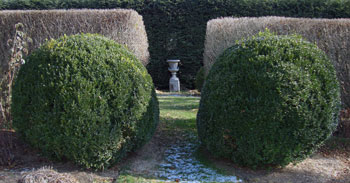 Buxus is a genus in the family Buxaceae, which also includes the genus Pachysandra. According to Ms. Batdorf, in 2009 there were 494 registered boxwood cultivars and hybrids, a dramatic increase from the 180 cultivars in 1961. I find boxwood taxonomy a bit confusing, but the most widely grown are Common (sometimes called American) Buxus sempervirens, English or dwarf Buxus Sempervirens suffruticosa and Japanese Buxus microphylla. With all the cultivars available today, the uses of boxwood are practically endless. They can be used alone or in a mixed foundation planting, to provide any sort of framework in formal gardens–to define borders, driveways or outdoor “rooms”–in addition to being used in planters or as topiaries or garden accents. They are evergreen 12 months of the year in many climates, so that whatever frame or focus they create in your garden can be year-round. In addition, the high alkalai content in the leaves makes them almost completely deer proof. They adapt to numerous light conditions, and work equally well with formal or informal landscaping and architecture from colonial to contemporary. Sam Bridge Nursery in Greenwich CT, which sells mainly sempervirens and suffruticosa, has seen a recent surge in boxwood sales because of the deer resistance. To prevent wind burn in their northeastern zone 6, they spray with an antidessicant two or three times throughout the winter. When planting small box in planters, they suggest lining the inside edge with bubble wrap for insulation. On the West Coast, there is a history of designing with Japanese boxwood, buxus japonica, since the 1920s. Inner Gardens in Los Angeles has the largest inventory of buxus species in southern California, and has seen a dramatic increase in the use of English boxwood in the last five years. Inner Gardens’ Stephen Block thinks it is because of “the introduction of highly finished shapes e.g., cones, globes, pyramids, squares and spirals spurred the rather sudden interest in these plants…we can plant finished borders and accent with pyramids or cones in an instant.” (PHOTO: BOXWOOD IN WINTER AT THE HOME OF PAGE DICKEY, GARDEN DESIGNER AND AUTHOR; CREDIT: NAN ZANDER)
Buxus is a genus in the family Buxaceae, which also includes the genus Pachysandra. According to Ms. Batdorf, in 2009 there were 494 registered boxwood cultivars and hybrids, a dramatic increase from the 180 cultivars in 1961. I find boxwood taxonomy a bit confusing, but the most widely grown are Common (sometimes called American) Buxus sempervirens, English or dwarf Buxus Sempervirens suffruticosa and Japanese Buxus microphylla. With all the cultivars available today, the uses of boxwood are practically endless. They can be used alone or in a mixed foundation planting, to provide any sort of framework in formal gardens–to define borders, driveways or outdoor “rooms”–in addition to being used in planters or as topiaries or garden accents. They are evergreen 12 months of the year in many climates, so that whatever frame or focus they create in your garden can be year-round. In addition, the high alkalai content in the leaves makes them almost completely deer proof. They adapt to numerous light conditions, and work equally well with formal or informal landscaping and architecture from colonial to contemporary. Sam Bridge Nursery in Greenwich CT, which sells mainly sempervirens and suffruticosa, has seen a recent surge in boxwood sales because of the deer resistance. To prevent wind burn in their northeastern zone 6, they spray with an antidessicant two or three times throughout the winter. When planting small box in planters, they suggest lining the inside edge with bubble wrap for insulation. On the West Coast, there is a history of designing with Japanese boxwood, buxus japonica, since the 1920s. Inner Gardens in Los Angeles has the largest inventory of buxus species in southern California, and has seen a dramatic increase in the use of English boxwood in the last five years. Inner Gardens’ Stephen Block thinks it is because of “the introduction of highly finished shapes e.g., cones, globes, pyramids, squares and spirals spurred the rather sudden interest in these plants…we can plant finished borders and accent with pyramids or cones in an instant.” (PHOTO: BOXWOOD IN WINTER AT THE HOME OF PAGE DICKEY, GARDEN DESIGNER AND AUTHOR; CREDIT: NAN ZANDER)
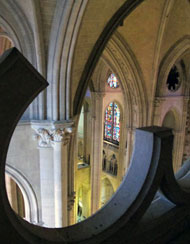 A Talk with Chris Pellettieri, Master Stone Carver
A Talk with Chris Pellettieri, Master Stone Carver
By Katy Keiffer
For this issue examining classical forms we checked in with our friend Chris Pellettieri, a working stone carver. Chris is the artist-in-residence at the Cathedral of St. John the Divine. We were privileged to have Chris take us on a guided tour of the upper reaches of the Cathedral where we could observe some of the extraordinary detail that makes up the internal and external decoration of the building. To the right is one of the amazing views we were able to take in on our tour.
 During the mid-70s, when the Very Reverend James Parks Morton, Dean of the Cathedral, initiated a plan to revive construction on the structure (work had halted as a result of America’s entrance into World War II), he discovered that there were very few master stone carvers still working. Thus, along with the construction, he started a training program for stone carvers that targeted local unemployed and underserved youth. Though Chris didn’t qualify as either, because of his long association with the Cathedral School, he was permitted to apprentice. Three years of training later, Chris emerged a fully proficient carver, able to letter, sculpt and even dress stone for building, a task typically accomplished by machinery nowadays. “I am most at home with the Gothic style but I have experience with and am able to do good work in many other styles including Classical (Greek and Roman), Romanesque and Renaissance”, Chris told me. (PHOTO: EXAMPLE OF SOME OF THE CARVING CREATED BY STUDENTS OF THE CATHEDRAL TRAINING PROGRAM, THE DARK STONE IN THE FOREGROUND DATES FROM THE ORIGINAL CONSTRUCTION)
During the mid-70s, when the Very Reverend James Parks Morton, Dean of the Cathedral, initiated a plan to revive construction on the structure (work had halted as a result of America’s entrance into World War II), he discovered that there were very few master stone carvers still working. Thus, along with the construction, he started a training program for stone carvers that targeted local unemployed and underserved youth. Though Chris didn’t qualify as either, because of his long association with the Cathedral School, he was permitted to apprentice. Three years of training later, Chris emerged a fully proficient carver, able to letter, sculpt and even dress stone for building, a task typically accomplished by machinery nowadays. “I am most at home with the Gothic style but I have experience with and am able to do good work in many other styles including Classical (Greek and Roman), Romanesque and Renaissance”, Chris told me. (PHOTO: EXAMPLE OF SOME OF THE CARVING CREATED BY STUDENTS OF THE CATHEDRAL TRAINING PROGRAM, THE DARK STONE IN THE FOREGROUND DATES FROM THE ORIGINAL CONSTRUCTION)
 Traditionally stone carvers work in two methods. In direct carving the sculptor cuts into a stone block to shape the stone without referring to a model created beforehand. For his own work, Chris dives right in with direct carving, but for commissions, he will usually opt for the pointing method. In this procedure a detailed model is produced first, typically from clay. The model is cast in a more durable material, usually plaster, and this plaster cast is then used as the guide. Chris showed me a really fabulous tool, called a “pointing machine”. The pointing machine, which resembles a four-point drafting compass, has been used for hundreds of years. First the points of the machine are positioned on the plaster model to take different measurements. When the spatial relations are set, the pointing machine is transferred to the block of stone. Three of the points fasten to the stone while the fourth is positioned where the cut is to be made, allowing the sculptor to readily see how much stone must be carved away. The pointing machine allows for very precise measurements, which map the model inch-by-inch. (PHOTO: POINTING MACHINE USED TO REPRODUCE A STATUE FROM THE STRASBOURG CATHEDRAL. CREDIT: JI-ELLE, WIKIMEDIA COMMONS)
Traditionally stone carvers work in two methods. In direct carving the sculptor cuts into a stone block to shape the stone without referring to a model created beforehand. For his own work, Chris dives right in with direct carving, but for commissions, he will usually opt for the pointing method. In this procedure a detailed model is produced first, typically from clay. The model is cast in a more durable material, usually plaster, and this plaster cast is then used as the guide. Chris showed me a really fabulous tool, called a “pointing machine”. The pointing machine, which resembles a four-point drafting compass, has been used for hundreds of years. First the points of the machine are positioned on the plaster model to take different measurements. When the spatial relations are set, the pointing machine is transferred to the block of stone. Three of the points fasten to the stone while the fourth is positioned where the cut is to be made, allowing the sculptor to readily see how much stone must be carved away. The pointing machine allows for very precise measurements, which map the model inch-by-inch. (PHOTO: POINTING MACHINE USED TO REPRODUCE A STATUE FROM THE STRASBOURG CATHEDRAL. CREDIT: JI-ELLE, WIKIMEDIA COMMONS)
Of the many other tools in the stone carver’s arsenal few have changed to any great degree. Perhaps the only significant difference is the composition of those tools, which are now produced from high-grade steel, making them harder and thus more efficient. Rasps and rifflers (files with curved faces for filing concave areas) are still used for smoothing surfaces and adding detail, while the flat chisel, point chisel and the claw, or toothed, chisel are used for removing bigger pieces and creating overall shape. Nowadays most people working in stone use laser cutting tools, water erosion, grinding or cutting wheels and the like, a complete departure from the spirit and processes used for so many centuries.
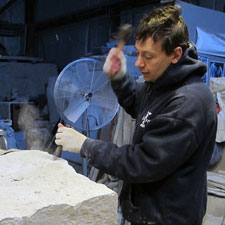 Every type of stone has its own characteristics, limitations and finish qualities. I asked Chris what his favorite is, and what is easiest to work on. “I enjoy working in limestone best and most of my work has been in that material. I have also been successful in marble, slate, sandstone and alabaster, which can all be worked using basically the same methods. Granite, however, is so much harder that working with it requires a whole different approach as well as a whole different set of expectations as to how much one can accomplish in a day or week (much less progress)…it can be hard to take for one who is accustomed to the ‘soft’ stones.” If he wants, Chris can attach a pneumatic device to his chisel to move the work along faster. But he explains, “I choose to do the majority of my stone carving work with hand tools not because I feel I have anything to prove, although I may have felt that way years ago, but rather for the same reasons I often choose to walk–it is a more pleasant way to work, it is healthier, it is more fun and, in most cases, the work comes out looking better.” (PHOTO: CHRIS PELLETTIERI WORKING ON A BLOCK OF LIMESTONE)
Every type of stone has its own characteristics, limitations and finish qualities. I asked Chris what his favorite is, and what is easiest to work on. “I enjoy working in limestone best and most of my work has been in that material. I have also been successful in marble, slate, sandstone and alabaster, which can all be worked using basically the same methods. Granite, however, is so much harder that working with it requires a whole different approach as well as a whole different set of expectations as to how much one can accomplish in a day or week (much less progress)…it can be hard to take for one who is accustomed to the ‘soft’ stones.” If he wants, Chris can attach a pneumatic device to his chisel to move the work along faster. But he explains, “I choose to do the majority of my stone carving work with hand tools not because I feel I have anything to prove, although I may have felt that way years ago, but rather for the same reasons I often choose to walk–it is a more pleasant way to work, it is healthier, it is more fun and, in most cases, the work comes out looking better.” (PHOTO: CHRIS PELLETTIERI WORKING ON A BLOCK OF LIMESTONE)
The most interesting and inspiring aspect of my conversation with Chris Pellettieri is his deep commitment to craftsmanship. “The dominant mentality today would seem to hold that if a machine can be invented that will make a task that requires skill into a task that doesn’t, then it is to be embraced without further reflection. The trend in the building industry enables workers to do more work in a shorter time with less training. The problem with this thinking, from my artisan’s point of view, is that my greatest feelings of satisfaction and fulfillment have come from overcoming challenges, by building up my skills rather than by making the work easier so that I can succeed without increasing my skills.”
Chris works on pieces for the Cathedral, as well as executing private commissions. Among the projects he’s produced for commission are staircases, fireplaces, fountains, memorials and portrait busts. Two of Chris’ fountains are pictured below. For more information on Chris Pellettieri, visit his website, www.stonecarving.us
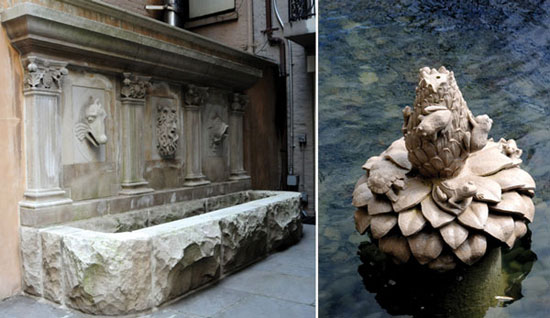
—————–
Looking forward to our next Focal Points that will highlight garden ornament in the collections of historic houses in the Hudson Valley of New York state.